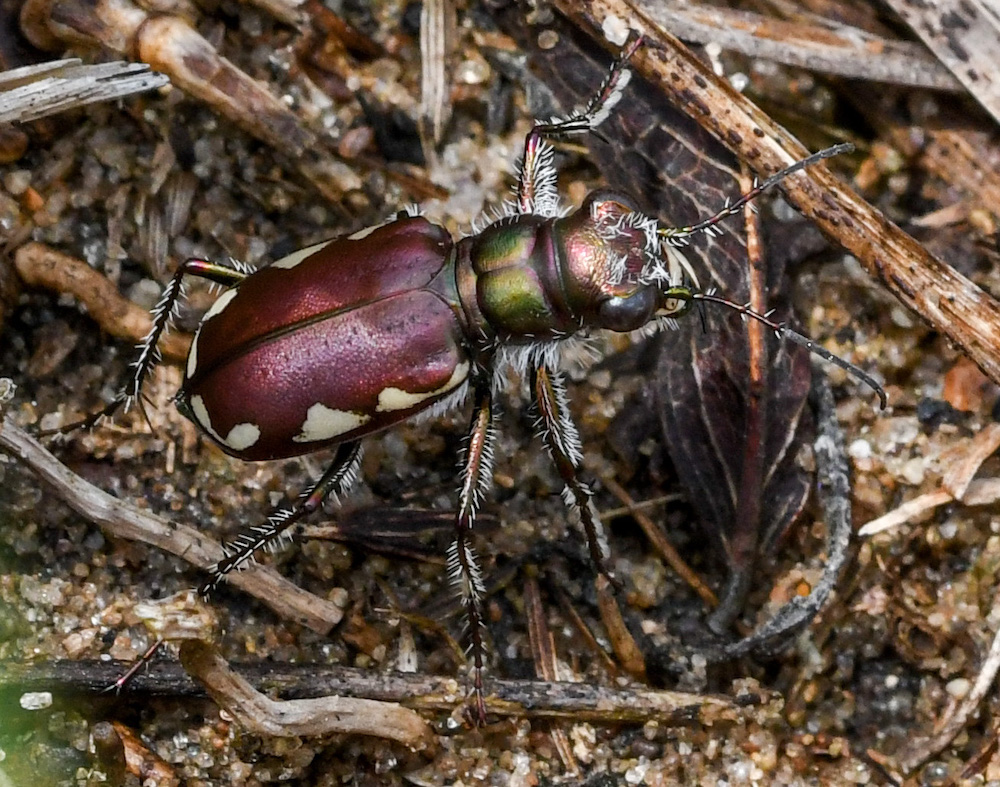
Photo by Steven D Bailey.



Photo by Steven D Bailey.

Along the great Illinois and Mississippi rivers lies a natural division of sandy plains, dunes and blowouts, various wetlands and blackjack oak-dominated scrub woodlands. These habitats provide homes to rare plants and animals such as the western hog-nosed snake, common nighthawk, red-headed woodpecker, blue grosbeak, Illinois chorus frog, ornate box turtle, prickly pear cactus and silvery bladderpod. The sand areas are also home to lots of cool and unusual insects, including the state-threatened regal fritillary butterfly and a myriad of bumble bees, beetles and grasshoppers.
“The biggest thing I love about the Illinois River and Mississippi River Sand Area Division is that the area is good for insects because of the soft soil for burrowing,” said Angella Moorehouse, a Natural Areas Preservation Specialist with the Illinois Nature Preserves Commission. Moorehouse, an insect specialist, researches regal fritillary butterflies in the central Illinois sands area of Mason, Cass and Morgan counties. Wisconsin glacial meltwaters created the ecosystem, carrying sand and gravel from the Illinois and Mississippi rivers into the region. “In Mason County, constant glaciation left a ton of sand, and the strong winds blew that sand. Most of the sand in the region is above underground aquifers, which supplies irrigation for growing pumpkins and watermelons,” Moorehouse said.

Though much of this region has been developed for farming and other uses, fine examples of the original landscape remain both in state and federal owned properties as well as agricultural conservation easements. These areas include several state-owned nature preserves: Sand Prairie Scrub-Oak, Long Branch Sand Prairie and the Henry Allan Gleason Preserve, within Sand Ridge State Forest.
In Illinois, certain species of grasshoppers and tiger beetles are almost exclusively found in this sandy realm between the rivers. Coral-winged grasshoppers blend in with the sand, but when they fly, the colors are beautiful, said Moorehouse who has seen these species at the Gleason Preserve.
Another sand-loving insect is the tiger beetle, of which several species exist including the big sand tiger beetle. It has a purplish bronze body with white patterning.

“We need tiger beetles because they are fantastic predators,” Moorehouse said. “They have massive jaws. They take out midges and mosquitoes. They keep insect populations in check.”
Insects need resources including plants that provide nectar and pollen. An important one in the region is the prickly pear cactus, which loves sandy soil. It flowers in June and July, attracting copious bees and other insects. The species is found in many parts of Illinois, but only where the proper dry, sandy soil conditions exist. At one of the state preserves in the division, Moorehouse has discovered an insect called the cactus coreid that spends its entire life feeding on the cactus and laying eggs on cactus spines.
A special sand community called a blowout is unique to this division.
“Blowouts are similar to a dune,” Moorehouse said, “but the wind scours it out in a circular motion leaving a crescent-shaped dune.” One plant that grows on or near these blow outs is the state-endangered silvery bladderpod.

Though the region is definitely sandy, plenty of wet areas offer habitats for rare amphibians such as the state-threatened Illinois chorus frog. “Ephemeral or temporary pools pop up when the water table is high,” attracting these rare amphibians,” Moorehouse said. She has found some of the amphibians in the midst of crop fields, on a wet spot near a road. That points to the importance of saving habitat, she said. One way to do that is through the state’s Conservation Reserve Enhancement Program. Farmers enroll a part of their land in the program, earning one-time payments and tax relief, but ensuring that land won’t be farmed for a certain number of years.
The state-threatened regal fritillary butterfly has found what Moorehouse calls habitat pivot corners to its liking. “These are places on edges of farm fields where irrigation doesn’t reach. I find a tremendous amount of diversity on those pivot corners,” she said.
Saving the habitats and the plants and animals that live within them also requires the right approach to doing prescribed burns. Historically, fires kept encroaching woods at bay. With those fires gone, land managers now introduce occasional burns to help maintain natural communities on the landscape. However, so much needs to be considered when doing prescribed burns, Moorehouse said. For example, regal fritillary butterflies spend their larval stage in the leaf litter from September to May. Not burning an entire site, leaving refugia for the larvae, and choosing the right timing is important for these butterflies. Monitoring is also done for the state-threatened ornate box turtle, which lives in sand prairies in the region, as it also can be negatively affected by prescribed burns that are conducted at inappropriate times.

To explore the unique habitats of the Illinois River and Mississippi River Sands Natural Division, visit Sand Prairie-Scrub Oak Nature Preserve in Mason County. This state-dedicated Nature Preserve features dry sand prairie, sand savanna and forest where you’ll find blackjack oaks, little bluestem and goat’s rue, eastern prickly pear cactus, plus examples of sand dunes and blowouts. The sand areas are a good place to find northern mockingbirds and blue grosbeaks. The 7,200-acre Sand Ridge State Forest near Manito contains large pine plantation planted by the Civilian Conservation Corps. But it also contains native oak woodlands and sand prairies to explore. It’s also close to the Gleason State Nature Preserve, accessed via Topeka Road, which can be hiked by those who enjoy going off the beaten path.
Sheryl DeVore writes environment and nature pieces for regional and national publications and has had several books published, including “Birds of Illinois” co-authored with her husband, Steven D. Bailey.
Submit a question for the author